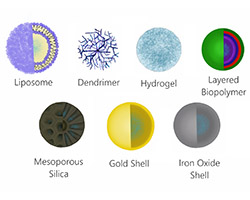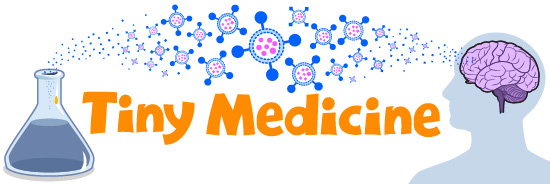Building Nanoparticles
A nanoparticle speeds through your body using the bloodstream as a highway, but then it stops at just the right spot to deliver the medicine it is carrying. You could say nanoparticles are like tiny mailmen dropping off packages. But these delivery particles are so small, your cells must seem like huge mountains in comparison. How do scientists make such tiny particles?
Nanoparticles Practically Make Themselves
Nanoparticles aren’t individually made piece by piece like our cars or computers. They’re made by mixing the right materials together. Nanoparticles make themselves because the materials they are made of attract and stick to each other. This is called self-assembly. The shape and size of the nanoparticles depend on the materials that are added, and the amounts of each used.
Nanoparticles Come in Many Forms

Scientists have used many materials to make nanoparticles, all with their own unique advantages. Many of these materials are organic, and are made by living things. These are used because they are similar to what is already in the body, so the immune system will let them stay there. They are also biodegradable, meaning they can be easily broken down into material that isn’t harmful to living things. These nanoparticles include shells of different organic molecules that can hold medicine on the inside, tree-like particles that bind medicine on their branches, and spongy particles that can soak up medicine dissolved in water.
Even though inorganic materials need an organic coat to avoid the immune system, they still have very useful properties. Materials like silica form particles with holes that can be filled with medicine. Gold or magnetic shell nanoparticles can be heated up and cause the cells they are in to die, which is useful for treating cancer.
Read more about: Latch and Catch
Bibliographic details:
- Article: Building Nanoparticles
- Author(s): Dr. Biology
- Publisher: Arizona State University School of Life Sciences Ask A Biologist
- Site name: ASU - Ask A Biologist
- Date published:
- Date accessed:
- Link: https://askabiologist.asu.edu/building-right-nanoparticles
APA Style
Dr. Biology. (). Building Nanoparticles. ASU - Ask A Biologist. Retrieved from https://askabiologist.asu.edu/building-right-nanoparticles
Chicago Manual of Style
Dr. Biology. "Building Nanoparticles". ASU - Ask A Biologist. . https://askabiologist.asu.edu/building-right-nanoparticles
Dr. Biology. "Building Nanoparticles". ASU - Ask A Biologist. . ASU - Ask A Biologist, Web. https://askabiologist.asu.edu/building-right-nanoparticles
MLA 2017 Style

Be Part of
Ask A Biologist
By volunteering, or simply sending us feedback on the site. Scientists, teachers, writers, illustrators, and translators are all important to the program. If you are interested in helping with the website we have a Volunteers page to get the process started.

